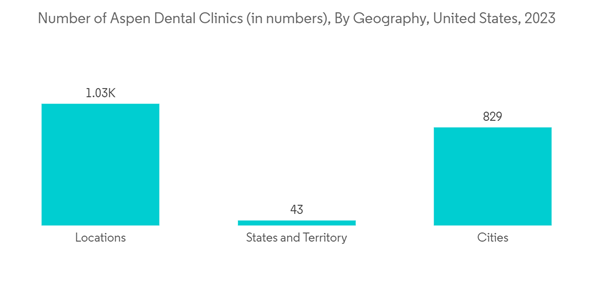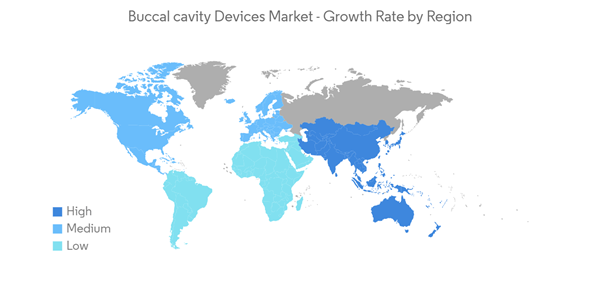Key Highlights
- The outbreak of the COVID-19 pandemic impacted the studied market significantly. With the strike of COVID-19 and lockdowns all over the globe and fear of co-infections during the initial days, the demand for dental procedures decreased. Additionally, the hospital visits associated with dental treatments and other dental surgeries decreased during the pandemic initially and hampered the adoption of oral or buccal cavity procedures, which adversely impacted the market studied.
- However, there has been increased awareness about oral health and maintaining healthy teeth during the later phases of the pandemic, which balanced the loss incurred by the market. For instance, the significance of dental health has been emphasized by the German Society of Dentistry and Oral Medicine (DGZMK), and the systemic relevance of dentistry, especially during the pandemic, published their survey result in December 2021.
- As per their survey, 39.1% of all participating doctors saw less than 600 patients per quarter, while 59.9% saw more than 600 patients. This shows a balance between oral care procedures during the pandemic, and considerably balanced the adoption of buccal cavity devices, driving the overall studied market. This is further anticipated to contribute to the overall market studied during the forecast period.
- The studied market growth is largely attributed to factors such as the increase in the prevalence of dental disorders, advancements in research and developments (R&D) in dentistry coupled with a rise in disposable income, and are expected to drive the studied market growth during the analysis period.
- The practice of keeping one's mouth (known as the buccal cavity) clean and disease-free following several tips is known as oral hygiene. It involves visiting the dentist regularly for dental X-rays, exams, and cleanings. With the high burden of oral diseases across countries worldwide, the demand for buccal cavity treatment is increasing, which is further creating demand for buccal cavity devices.
- For instance, as per World Health Organization (WHO) data updated in May 2023, even if oral diseases are preventable with treatment and care, nearly 3,500 million people are affected by oral diseases.
- Additionally, as per the data published by the United Health Foundation in 2021, the prevalence of full-mouth teeth extractions due to tooth decay or gum disease among older adults is higher in females than males and those with an annual household income of less than USD 25,000 in the United States.
- In addition, as per the above source, the prevalence of oral diseases is more than 7 times higher than those with a household income of USD 75,000 or more annually, and the prevalence decreases with each increase in income level. Therefore, the burden of diseases among poor and aging populations is predicted to have a positive impact on buccal cavity treatment and is anticipated to fuel demand for buccal cavity devices and accelerate market expansion over the course of the projected period and beyond.
- However, the high cost associated with intra-oral flat panel sensor products is one of the major factors that is predicted to hamper the market's growth.
Buccal Cavity Devices Market Trends
Intraoral Scanner Segment is Expected to Grow Significantly Over the Analysis Period
- Standalone devices are expected to witness promising growth due to the improved workflow of dental professionals in oral scanning procedures and improved outputs of these devices. But, due to the introduction of miniature portable intraoral scanners in the market, incorporating the side-oriented tip in small intraoral scanners has made the buccal surface scans much more accessible, quicker, and more effective.
- Thus, the enhanced output offered by these devices is expected to fuel the segment's growth. Oral illnesses affect people throughout their lives, causing pain, suffering, disfigurement, and sometimes death. They are a significant health burden for many nations.
- According to data by the Centers for Disease Prevention (CDC) published in 2021, about half (46%) of all persons aged 30 or older have gum disease; about 9% of adults have severe gum disease. Additionally, according to the October 2021 Borgen Project, 60% to 80% of kids and 85% to 90% of adults both have dental caries. The market for intraoral scanners is expected to grow due to this increasing demand for dental services.
- A new wireless wand with the same speed, precision, and lightness, the i700 wireless intraoral scanner, was also introduced by Medit in April 2021. Therefore, the intraoral scanner market is anticipated to rise over the forecast period due to the benefits associated with them, the rising demand for scanners, and the growing focus by significant players on developing and marketing improved scanners.
- Businesses are investing in this sector due to the increasing demand for scanners. The segment is thus anticipated to expand throughout the forecast period due to the benefits associated with scanners and the growing demand for scanners to assess various dental conditions.
North America is Expected to Hold a Significant Share of the Market Studied
- The market for buccal cavity devices in North America is expected to grow during the forecast period, owing to the factors such as the rising prevalence of oral diseases and a well-established healthcare system. Additionally, the American Dental Association is eager to educate the target population about the value of good dental hygiene, which is anticipated to spur market expansion.
- The 2021 annual report published by the United Health Foundation (UHF) showed that 1 in 4 adults has untreated cavities, and nearly half of the adults aged 30 years and older have signs of gum disease in the United States.
- Additionally, according to the American Dental Association (AMA), in June 2021, 85% of people were highly concerned about their dental health in the United States in recent years, increasing the demand for oral treatment and is anticipated to fuel the market's growth during the forecast period.
- Furthermore, according to data updated by the Centers for Disease Prevention (CDC), in February 2021, about one-third of Americans have untreated tooth decay and poor dental health. This is directly linked to heart problems and other health concerns.
- Therefore, an increasing number of dental problems may augment the demand for prosthodontics and orthodontics treatments in the country, which is likely to create opportunities for dental or intraoral devices and drive the growth of the market in the country. Hence, due to the burden of the disease in the country, the demand for buccal cavity devices is increasing, driving the overall market growth.
Buccal Cavity Devices Industry Overview
The buccal cavity devices market is competitive and fragmented in nature, with the presence of various well-known service providers globally. Major market players are competing against each other by expanding their range of services. There are many providers that are currently active in the market without any dominant market player. Some of the service providers are Dentsply Sirona, ACTEON Group Ltd., Align Technology Inc., Carestream Dental LLC, and Cyber Medical Imaging, Inc., among others.Additional Benefits:
- The market estimate (ME) sheet in Excel format
- 3 months of analyst support
This product will be delivered within 2 business days.










